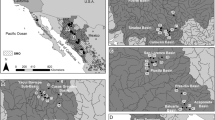Abstract
We document isolation and characterization of 13 tri- and tetranucleotide microsatellite DNA markers in brook trout (Salvelinus fontinalis). These markers displayed moderate to high levels of allelic diversity (averaging 20.5 alleles/locus) and heterozygosity (averaging 53.5%) in a range-wide survey of more than 13,000 fish. A comparison of two geographically proximal populations located on opposite sides of the eastern continental divide in Maryland, USA, found no deviations from Hardy–Weinberg equilibrium and minimal linkage disequilibrium. Microsatellite markers developed for S. fontinalis yielded sufficient genetic diversity to: (1) produce unique multilocus genotypes; (2) elucidate phylogeographic structure; and (3) provide unique demographic perspectives of population sizes and historical demographics. This suite of markers also provided considerable cross-species amplification utility among related salmonids.
Similar content being viewed by others
References
Cornuet JM, Luikart G (1996) Description and power analysis of two tests for detecting recent population bottlenecks from allele frequency data. Genetics 144:2001–2014
Davies N, Villablanca FX, Roderick GK (1999) Determining the source of individuals: multilocus genotyping in nonequilibrium population genetics. Trends Ecol Evol 14:17–21
Flebbe PA, Roghair LD, Bruggink JL (2006) Spatial modeling to project a southern Appalachian trout distribution in a warmer climate. Trans Am Fish Soc 135:1371–1382
Guffey SZ, McCracken GF, Moore SE, Parker CR (1998) Management of isolated populations: Southern strain brook trout. In: Peine JD (ed) Ecosystem Management for Sustainability: Principles and Practices Illustrated by a Regional Biosphere Reserve Cooperative. CRC Press LLC, Boca Raton
Hudy M, Thieling TM, Gillespie N, Smith EP (2008) Distribution, status, and land use characteristics of subwatersheds within the native range of brook trout in the eastern United States. North Am J Fish Manag 28:1069–1085
King TL, Eackles MS, Young CC (2006a) Microsatellite DNA markers for assessing phylogeographic and population structure in Preble’s meadow jumping mice (Zapus hudsonius preblei) and cross-amplification among neighboring taxa. Mol Ecol Notes 6:670–673
King TL, Switzer JF, Morrison CL, Eackles MS, Young CC, Lubinski BA, Cryan P (2006b) Comprehensive genetic analyses reveal evolutionary distinction of a mouse (Zapus hudsonius preblei) proposed for delisting from the US endangered species act. Mol Ecol 15:4331–4359
Luikart G, Sherwin WB, Steele BM, Allendorf FW (1998) Usefulness of molecular markers for detecting population bottlenecks via monitoring genetic change. Mol Ecol 7:963–974
Peacock MM, Kirchoff VS, Merideth SJ (2002) Identification and characterization of nine polymorphic microsatellite loci in the North American pika, Ochotona princeps. Mol Ecol Notes 2:360–362
Peakall R, Smouse PE (2006) GENALEX 6: genetic analysis in Excel. Population genetic software for teaching and research. Mol Ecol Notes 6:288–295
Perry GML, King TL, St.-Cyr J, Valcourt M, Bernatchez L (2005) Isolation and cross-familial amplification of forty-one microsatellites for the brook char (Salvelinus fontinalis). Mol Ecol Notes 5:346–351
Piry S, Luikart G, Cornuet J-M (1999) BOTTLENECK: A computer program for detecting recent reductions in the effective population size using allele frequency data. J Hered 90:502–503
Raymond M, Rousset F (1995) GENEPOP (version 1.2): population genetics software for exact tests and ecumenicism. J Hered 86:248–249
Rice WR (1989) Analyzing tables of statistical tests. Evolution 43:223–225
Taberlet P, Luikart G (1999) Non-invasive genetic sampling and individual identification. Biol J Linn Soc 68:41–55
Waples RS (2006) A bias correction for estimates of effective population size based on linkage disequilibrium at unlinked gene loci. Conserv Genet 7:167–184
Acknowledgments
This research was funded by the U.S. Geological Survey’s (USGS) and National Park Service’s (NPS) joint Natural Resource Preservation Program (NRPP) with additional funding provided by the USGS Leetown Science Center. The authors wish to thank Roseanna Coleman, Shannon Julian, and Colleen Young for critical laboratory assistance. This article is in partial fulfillment of a final report for NRPP. The authors wish to thank Diane Pavek (Research and T&E Coordinator, National Capital Region, National Park Service) for coordination of this research project. This article also serves as contribution 1676 of the USGS Great Lakes Science Center.
Author information
Authors and Affiliations
Corresponding author
Rights and permissions
About this article
Cite this article
King, T.L., Lubinski, B.A., Burnham-Curtis, M.K. et al. Tools for the management and conservation of genetic diversity in brook trout (Salvelinus fontinalis): tri- and tetranucleotide microsatellite markers for the assessment of genetic diversity, phylogeography, and historical demographics. Conservation Genet Resour 4, 539–543 (2012). https://doi.org/10.1007/s12686-012-9603-z
Received:
Accepted:
Published:
Issue Date:
DOI: https://doi.org/10.1007/s12686-012-9603-z




